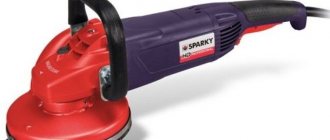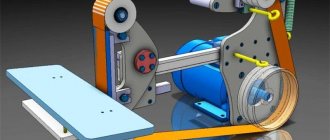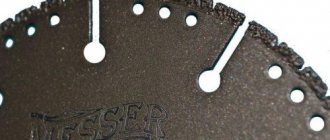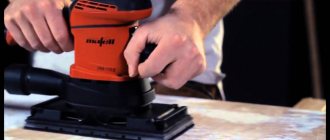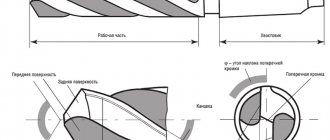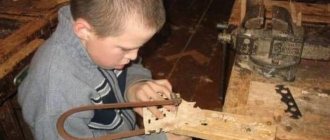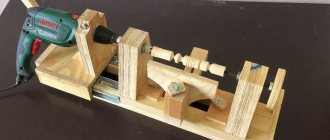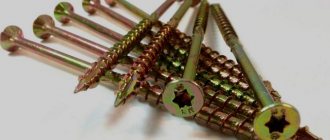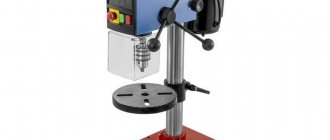Types of sanders
There are six types of grinders, differing in the stroke of the grinding material and configuration:
- Circular;
- Longitudinal;
- Rotational, reciprocating.
Manufacturers produce tools that work both from the mains and with a battery.
Useful tips when working with a sander
If you need to sand a varnished surface, then you should set the tool to the lowest speed, since the varnished coating is sensitive to high temperatures. It is necessary to monitor the temperature conditions and regularly allow the surface to “cool” after each stage of grinding. To avoid creating unnecessary friction, you should use clean abrasives and do not press the tool with force. If you need to sand plastic, it is best to use an eccentric or vibration sander. Again, you need to set the minimum speed of the tool. The grain size of the sandpaper should be more than 240. Similar types of machines should be used if you need to sand a metal surface. However, the grain size should already be more than 600. To sand off the unevenness, you will have to use a grinder. If finer processing of the material is required, then you should think about using fiber or fan discs. The belt sander must first be turned on, and only then brought to the surface that needs to be processed. Otherwise, the tool may be thrown away from the workpiece at high speed (up to 25 km/h). When sanding, do not put too much pressure on the machine. Normal surface contact is sufficient for an effective grinding process. With strong pressure, the material will be removed in an increased volume, but this will affect the quality of grinding.
Photo: bosch-online.ru
When working with an angle grinder, be sure to use safety glasses. These sanders are the most dangerous. To ensure that the tool works reliably, regularly remove dust from the cavities of the angle grinder. This can be done by blowing and tapping the housing. Avoid overload. In this case, the service life of the tool will be maximum. The ends of the material being processed should not bite the cutting disc, otherwise its service life will not be long. To avoid this, it is necessary to ensure constant pressure on the grinder. At the same time, you should not make very deep cuts in one go, since this increases the load on the motor several times, which can cause damage even to a professional angle grinder.
Angle Grinder
An angle grinder, or popularly “grinder”, has an axis to which a cutting or grinding disc is attached, located at ninety degrees in relation to the electric drive rod.
- It is also used for grinding metal products, seams after welding, and removing the previous layer.
- For these purposes, a variety of attachments are used - felt sanding discs, flap brushes.
- Angler grinders are most often used for grinding metal, due to the high rotation speed of the electric motor (over ten thousand revolutions per minute).
It is possible to work with such indicators only by rough grinding of surfaces; it will not be possible to do better work at such speeds, especially on soft materials. The “grinder” has one significant disadvantage - the lack of proper dust removal.
Stationary units
Stationary units include belt-plate grinding machines.
The stationary grinder is used mainly in small carpentry workshops or in small-scale production. The unit consists of a belt sander and a grinding wheel. Thanks to the installed table on the machine, you can round the corners of workpieces, grind the edges of parts, and also grind them at a certain angle.
Belt sanding
The belt sander got its name from a solid abrasive sanding belt located on two shafts, one of which is the drive shaft.
This type of tool has a high belt speed and excellent productivity. Thanks to these qualities, the electric grinder is used for finishing work - fine grinding, before processing the product with paints and varnishes.
In addition, they are used during the construction stages to remove:
- Previous paint coating;
- Rusty coating;
- Excess on primed, plastered surfaces.
This type of sander is equipped with a closed dust extraction structure with the ability to connect a vacuum cleaner. In addition, on this model it is possible to install it upside down, so that the sanding belt can be aligned. To do this, the tool is secured using clamps included with the workbench. This function allows you to sharpen knives, bench tools, drills, using the grinder as a mini-grinder.
Types of grinders
Based on the principle of operation, such devices can be divided into two main types: pneumatic and electric.
The main advantage of pneumatic models is their light weight and relatively low cost. Such devices are very often used as a professional tool, since even with prolonged use, hands do not get tired and labor productivity does not decrease. These positive qualities can be explained very simply - pneumatic devices do not have motors. Their working mechanism is driven by the pressure of compressed air supplied through a hose from a special compressor.
The main disadvantage of pneumatic sanders is the presence of a bulky compressor. In other words, such a tool can only work in a workshop where there is a possibility of supplying compressed air. That is why devices of this type are mainly used in car services and are rarely used for repair work. If such equipment is used to carry out repairs in your own apartment, you will have to additionally purchase an expensive compressor.
As for electric models, their main advantage is high mobility. It is almost always possible to connect to the mains, and using an extension cord is absolutely no problem. The disadvantages of power tools include their relatively large weight and overall dimensions, as well as their high cost.
If a grinding machine is chosen for renovation work in a house or apartment and will not be used in the future on large construction projects, then the obvious choice is in favor of electric models.
According to the method of influencing the surface being processed, grinders can be divided into the following groups:
- Tape.
- Vibrating.
- Eccentric (orbital).
Let's take a closer look at each of these types of grinding machines.
Vibrating
Another name that many people know is a surface grinder. It received its second name thanks to a flat rectangular platform, which, with the assistance of an eccentric electric mechanism, makes reciprocating moves over the entire surface of the product.
Sanding attachments include rectangular sandpaper sheets attached to the surface of the sole using special clips or Velcro. Grinding machines are used for finishing work on various products.
However, the design of the tool does not allow access to corners and joints during grinding; in this case, a delta grinder is used, which is one of the varieties of this group.
Here the working surface resembles a triangle with an acute angle protruding forward. This design perfectly allows you to get into hard-to-reach places, while doing the job efficiently. Since the delta grinder is not used so often, only when necessary, these models are often produced with a battery.
Application
Using a delta sander, fine grinding of protrusions, blind corners, edges, profiles, cleaning of exposed glue, processing of objects with small parts and complex surfaces are performed.
Delta grinder “iron” for 1,500 rubles using my link. Excellent reviews, fast delivery, quality product. View >>>
Particularly good in carpentry, furniture making, staircases, and automotive body work, used as a main tool or in addition to eccentric or orbital sanders.
USEFUL INFORMATION: How to properly glue wallpaper (video)
Orbital (eccentric) electric sander
The working platform of an eccentric grinder is a circle that rotates and makes reciprocating movements. An eccentric device with two rollers allows this to be done (hence the second name of the tool).
The first is the axis of the grinder disk, shifted relative to the center by a couple of millimeters.
- Self-rotation is carried out through another roll passing through the middle of the circle in a circle around the shaft.
- Using this type of sander, you can achieve excellent grinding quality; in addition, you can polish the surface of the product coated with varnish.
- It is because of this that they are valuable in furniture, restoration, car repair shops and other enterprises where the quality of polishing and grinding of products is important.
What to consider when choosing?
The choice of tool design is carried out based on the characteristics of the work. This takes into account the type of material and surface. The easiest surface to process is a flat one. Before choosing, you should look at reviews, video reviews, manufacturer ratings and model ratings. They can tell you a lot about specific instrument models. Moreover, both quality and popularity ratings are useful.
You also need to consider not only how much the tool itself costs, but also the cost of components and spare parts for grinding machines. The maintenance price includes abrasive items, such as sandpaper for a sander. Such equipment is used by a flat machine; other options require discs and brushes.
Brush grinder
There are two types of brush grinding, which are similar in appearance to angle grinders and belt grinding. In the first type, the axis of rotation is also located at an angle of 90 degrees with respect to the electric drive, which is located in the elongated handle.
This model differs from an angle grinder in that the brush model has a much lower rotation speed. Also, the handle is on a completely different side.
- The second model is equipped with the same rectangular platform, only there will be only one roller, which acts as a drive.
- Its diameter is significantly larger than that of belt grinding.
- The scope of use of these models is the removal of oxidation, rusty layer, and previous coating from the surface of products before proceeding with finishing.
In addition, these products use round or cone-shaped pads to which sandpaper or felt is fixed. Thanks to this, you can grind or polish the surface.
Sanding machine for putty, walls and ceilings
There are special representatives of grinding tools that are designed for working with large areas on walls and ceilings, grinding plaster and putty. A special feature of such models is the presence of a convenient telescopic handle and gearbox, as well as the ability to install large-diameter grinding wheels on them (usually 215 or 225 mm). Sanders for walls and ceilings can be used not only to smooth putty surfaces, but also to remove old paint and varnish coatings, as well as for grinding stone or concrete walls. The use of such a tool will significantly reduce the time and labor required for grinding work.
Crosscut, straight model
They are the simplest of this category of tools. Used for minor work - trimming, stripping, sanding. In appearance it is an elongated body with an electric motor.
In this case, the working element is sanding attachments in the form of a cylinder, cone, or sphere of not very large shape. Both cutting and flap discs can also be used.
Delta sanders
Delta sanders are ideal for sanding corners.
If you decide to restore old furniture, window frames or blinds, then this machine will become your indispensable assistant. The operating principle of a delta grinder is similar to vibrating models of grinding machines, however, the special shape of their grinding plate makes it possible to process surfaces in narrow and hard-to-reach places. The power consumption of such a tool is only 100 - 300 W. Dust is removed into a special container. If you decide to choose a delta sander, please note that the sanding sheet is attached only with Velcro. To save money, some manufacturers have developed models that allow you to rotate the sanding sheet in the desired direction and use its surface to achieve maximum abrasion.
For delta sanders, you can purchase additional sanding or cleaning cloth to clean metal surfaces from rust, process hard-to-reach wooden parts, and matt varnish coatings. Polishing sheets will allow you to correctly carry out finishing, polishing and rubbing.
The supplied plate nozzles will allow the master to easily penetrate the narrowest crevices. If someone has once used a sanding plate with a flat or oval tongue, he will easily take on the processing of concave or rounded parts.
How does a household appliance differ from a professional one?
There are several main differences that are undoubtedly worth paying attention to when choosing a tool:
- Working hours. The household tool can be used without stopping for five to ten minutes, after which the machine should be allowed to cool for some time. A professional model can work from fifteen to twenty minutes, and she needs literally five minutes to rest.
- Terms of use, level of protection. It is immediately clear that a more serious instrument (professional) will look better in relation to the “amateur” one. It will better “swallow” dust and moisture, and “steadfastly” withstand wire breakdowns and long-term operation.
- Durability. For a household tool, it will be enough to work for two to three hours a day and that’s it, but a professional tool can withstand two full-fledged work shifts.
In addition, a professional tool has additional “bells and whistles,” but a household model may have them, but only a top-tier tool. It is clear that the manufacture of serious power tools requires high-quality materials and excellent fittings.
And they are several times more expensive compared to household ones. Most well-known manufacturers make it easier for their customers to choose by releasing instruments on store shelves where the body is made in different colors. For example, Bosh, blue is professional, green is amateur.
Choosing a manufacturer
High-quality sanders are produced by companies such as Interskol, Bosh , Hitachi , Makita, DeWalt . It’s no wonder that these brands are on everyone’s lips. The durability of the tools from these companies is combined with excellent performance, high efficiency and reliability of engines of various powers. The models are double insulated, and most also have a built-in dust removal system. For this purpose, the machines are equipped with a special dust collector. It is also possible to connect them to an industrial vacuum cleaner. And all this is combined with an affordable price. Another advantage of these tools is their excellent ergonomics. Among the imported manufacturers of grinding machines, it is worth highlighting Skil , Meister, Metabo , KRESS , and Black&Decker . High-quality Russian brands are Zubr and Interskol . Makita brand is the pride of Austria and Germany. The grinders of this company are a joint product of these countries. The main model range is represented by professional tools, but household models are also quite diverse. Convenience, reliability and quality/price ratio are the main features of the tools of this company. The largest assortment of Makita among drawing machines. Increased engine sealing is the difference between vibrating grinders from this company. Maximum performance is represented by grinders and eccentrics. The prices for the tools of this company are very diverse (this is due to the huge selection of models). For example, an eccentric sander from Makita can be bought for 3-12 thousand rubles. The price of vibrating grinders is 1.5-8 thousand, brush grinders - 12-16 thousand, belt grinders - 4-10 thousand, and the price of grinders is about 6 thousand. Cordless angle grinders are several thousand rubles more expensive. The most expensive are concrete grinders (from 20 thousand rubles). The Japanese brand Hitachi is a guarantor of durability and safety. The performance and reliability of grinders of this brand is no worse than that of Makita. The company specializes in premium instruments. The brand has existed for more than fifty years. During this time, the company managed to create and patent many developments and technologies. The range of sanders is rich both in the class of household tools and professional ones. A Hitachi belt sander can be bought for 4-8 thousand rubles, a vibrating one for 2.5-4 thousand, a polishing machine for 6-9 thousand, and an eccentric one for only 1 thousand rubles. Hitachi grinders are represented by a huge range of models, so the price range is from 2 to 10 thousand rubles. A cordless grinder can be bought for 14 thousand rubles. The German brand Bosch has been on everyone's lips for decades. Swiss and German production is represented by a range of professional tools. Poland and China manufacture household grinding machines from this company. The most popular are Bosch belt and random orbital sanders as they are the most highly efficient. The price of Bosch vibration grinders is 4-8 thousand rubles, eccentric - 3-6 thousand, concrete grinders - from 16 thousand, straight - 16-20 thousand, belt - 6-10 thousand rubles. Bosch grinders are also presented in a wide range and their price ranges from 2.5 to 8 thousand rubles. Meister company is a fairly fresh brand that is distinguished by its reasonable prices for high-quality goods. Meister grinders are made in Germany, they are convenient and easy to use when working. Such tools are suitable for both home and garden use, as well as for construction work.
What you should pay attention to
Before you go to the store to buy something, you should think again about where and what it will be used for.
After all, not only the price range will depend on this, but also the additional materials that will need to be purchased:
- If a sander is needed to remove old paint from a wooden floor in a country house, then in this case ordinary belt sanding will be sufficient. Moreover, its cost will not be very high, about several thousand, but it should have good reviews.
- If you are purchasing a tool for a home workshop, where carpentry work will be carried out on the manufacture of furniture and interior items, then you should think about buying a good orbital sander with excellent performance and speed.
However, no matter what tool you plan to purchase, it is worth considering the following indicators, which are relevant for all types of grinders:
- Speed of surface movement;
- Availability of speed control;
- How often will the abrasive material need to be changed?
- Availability of additional devices on the market;
- Equipped with spare batteries, handles;
- Possibility of connecting a vacuum cleaner, adapter;
- Noise level, vibration;
- Warranty, service.
In addition, you can find out how far the warranty workshops are from your place of residence, as well as how much the delivery of the purchased product will cost.
So you can choose any tool, the most important thing is that it works properly, is in demand, and is easy to maintain. You should not avoid reviews from real customers, as you can glean a lot of useful information from them that you would never get from the seller.
The most popular types of grinders
Direct.
Ideal for sanding surfaces in difficult to reach areas. This is due to the presence of a long proboscis on the instrument, at the end of which the equipment is fixed. The spindle in such a grinder is located along the axis of the body, which explains the name. It is available in both electric and pneumatic versions - the latter option copes better with cleaning welds and removing edge burrs, while for leveling surfaces it is better to buy an electric grinder.
Angular.
They are angle grinders. They are Bulgarians. A tool that every master encounters in one way or another in his practice. It acquired its name due to the special location of the spindle - on the angular gearbox. Its main advantage is its wide range of work. Using an angle grinder, you can sand and polish a wooden surface, clean metal from rust, peel paint from wood/metal/concrete, and bring concrete floors and walls into a perfectly smooth state. The specific functionality of the grinder depends on the attachments, which often include diamond cups.
Vibrating.
They have a very simple design, the main role of which is played by a flat and fairly large sole. It is on the sole that sandpaper sheets are fixed, allowing you to quickly and efficiently cope with a large volume of work, and also performs well when sanding internal corners. The quality of processing of a vibrating tool is slightly lower than that of an orbital analogue, but you can buy such a grinding machine at a very reasonable price.
Note:
A separate subtype of vibrating grinders are
deltoid devices
, which got their name due to the special shape of the sole. Such machines are very miniature and maneuverable, capable of “climbing” into the most inaccessible areas, so they often occupy a worthy place in auto repair shops.
Orbital.
Also called eccentric. Absolute leaders in the quality of grinding and polishing, actively used for the most “delicate” work – including on varnished surfaces. They are especially appreciated by car service technicians, because “orbitals” allow not only to perfectly prepare the body for painting, but also to polish it afterwards. The main feature of such devices is that grinding is carried out through circular movements of the sole. During the rotation process, the sole eliminates unevenness, removing millimeters from the surface of a particular material (be it metal, wood or plastic), while vibration allows it to be cleaned in a timely manner. Most often, eccentrics with a standard stroke amplitude of 5 mm are used, but car mechanics prefer to buy an orbital sander with an amplitude of up to 3 mm. Machines of this type can be either electric or pneumatic.
Tape.
Most of them are very powerful power tools that operate at high speeds. The equipment is sandpaper glued together in a ring, which is fixed on the rotating rollers of the machine. During the grinding process, the belt moves along a flat pressure table. Such a unit can easily cope with both leveling wooden surfaces and removing layers of paint and rust from metals. There is only one “but”: after sanding with a belt machine, the surface may become covered with small scratches.
Also on the modern market there are more specific types of tools that are in demand in professional circles. Each of these models, due to its design features, can best cope with a particular task. So:
- for leveling and polishing mosaic (as well as concrete) floors,
machines with the appropriate name are often used - mosaic, working with special Frankfurt cutters; - for processing parquet boards,
drum devices are used, where the equipment is a 70 cm X 20 cm sanding belt; - sand the surface of ceilings and walls
with a disc sander - it is good for putty, and for old paint/whitewash, and for gypsum boards; - processing wood and metal in areas with difficult access
can be done well by a roller machine with a specific “proboscis”; - pipes can be perfectly polished
by a special roller model, available in both mains and battery versions; - For stone surfaces
, a planetary type grinder equipped with flexible diamond-coated discs is suitable; - Well, in order to give the wood coating a special relief, an aged effect and other “highlights”
, professionals recommend buying a brush-type sander - this unit is a leader in terms of “compatibility” with a wide variety of attachments.
